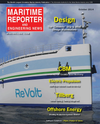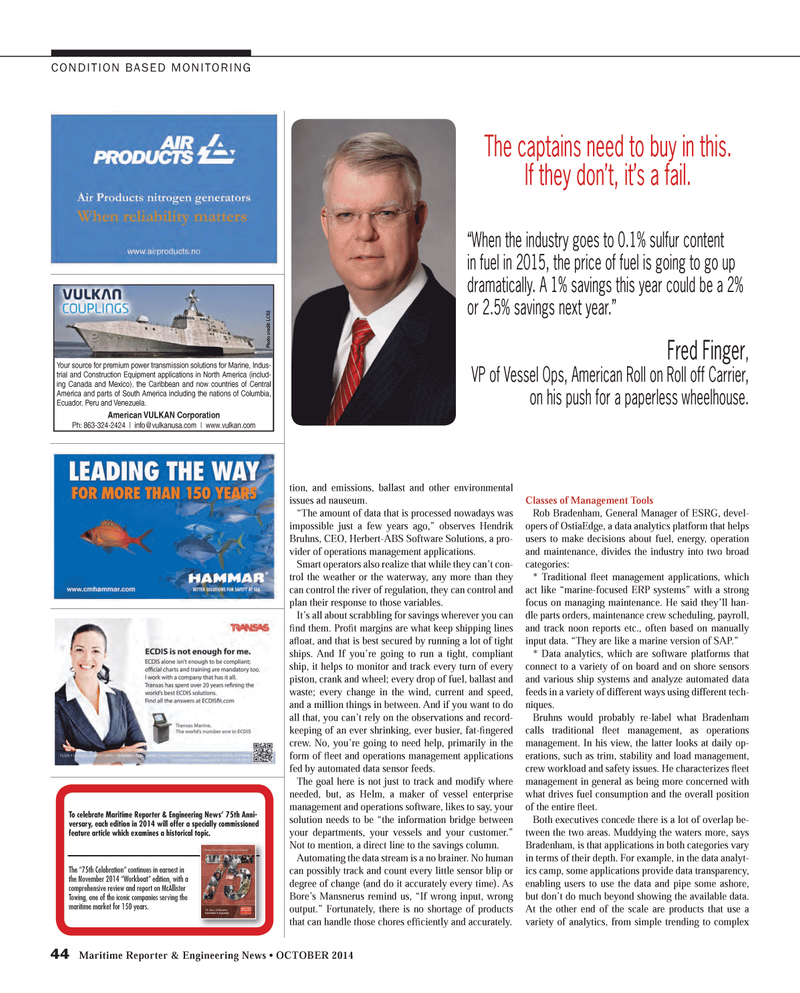
Page 3rd Cover: of Maritime Reporter Magazine (October 2014)
Marine Design Edition
Read this page in Pdf, Flash or Html5 edition of October 2014 Maritime Reporter Magazine
44 Maritime Reporter & Engineering News • OCTOBER 2014
CONDITION BASED MONITORING
American VULKAN Corporation
Ph: 863-324-2424 | [email protected] | www.vulkan.com
Your source for premium power transmission solutions for Marine, Indus- trial and Construction Equipment applications in North America (includ- ing Canada and Mexico), the Caribbean and now countries of Central
America and parts of South America including the nations of Columbia,
Ecuador, Peru and Venezuela.
Photo credit: LCS2
American Vulkan MR Jan14.indd 1 12/19/2013 9:55:54 AM tion, and emissions, ballast and other environmental issues ad nauseum. “The amount of data that is processed nowadays was impossible just a few years ago,” observes Hendrik
Bruhns, CEO, Herbert-ABS Software Solutions, a pro- vider of operations management applications.
Smart operators also realize that while they can’t con- trol the weather or the waterway, any more than they can control the river of regulation, they can control and plan their response to those variables.
It’s all about scrabbling for savings wherever you can fi nd them. Profi t margins are what keep shipping lines afl oat, and that is best secured by running a lot of tight ships. And If you’re going to run a tight, compliant ship, it helps to monitor and track every turn of every piston, crank and wheel; every drop of fuel, ballast and waste; every change in the wind, current and speed, and a million things in between. And if you want to do all that, you can’t rely on the observations and record- keeping of an ever shrinking, ever busier, fat-fi ngered crew. No, you’re going to need help, primarily in the form of fl eet and operations management applications fed by automated data sensor feeds.
The goal here is not just to track and modify where needed, but, as Helm, a maker of vessel enterprise management and operations software, likes to say, your solution needs to be “the information bridge between your departments, your vessels and your customer.”
Not to mention, a direct line to the savings column.
Automating the data stream is a no brainer. No human can possibly track and count every little sensor blip or degree of change (and do it accurately every time). As
Bore’s Mansnerus remind us, “If wrong input, wrong output.” Fortunately, there is no shortage of products that can handle those chores effi ciently and accurately.
Classes of Management Tools
Rob Bradenham, General Manager of ESRG, devel- opers of OstiaEdge, a data analytics platform that helps users to make decisions about fuel, energy, operation and maintenance, divides the industry into two broad categories: * Traditional fl eet management applications, which act like “marine-focused ERP systems” with a strong focus on managing maintenance. He said they’ll han- dle parts orders, maintenance crew scheduling, payroll, and track noon reports etc., often based on manually input data. “They are like a marine version of SAP.” * Data analytics, which are software platforms that connect to a variety of on board and on shore sensors and various ship systems and analyze automated data feeds in a variety of different ways using different tech- niques.
Bruhns would probably re-label what Bradenham calls traditional fl eet management, as operations management. In his view, the latter looks at daily op- erations, such as trim, stability and load management, crew workload and safety issues. He characterizes fl eet management in general as being more concerned with what drives fuel consumption and the overall position of the entire fl eet.
Both executives concede there is a lot of overlap be- tween the two areas. Muddying the waters more, says
Bradenham, is that applications in both categories vary in terms of their depth. For example, in the data analyt- ics camp, some applications provide data transparency, enabling users to use the data and pipe some ashore, but don’t do much beyond showing the available data.
At the other end of the scale are products that use a variety of analytics, from simple trending to complex
To celebrate Maritime Reporter & Engineering News’ 75th Anni- versary, each edition in 2014 will offer a specially commissioned feature article which examines a historical topic.
The “75th Celebration” continues in earnest in the November 2014 “Workboat” edition, with a comprehensive review and report on McAllister
Towing, one of the iconic companies serving the maritime market for 150 years. “When the industry goes to 0.1% sulfur content in fuel in 2015, the price of fuel is going to go up dramatically. A 1% savings this year could be a 2% or 2.5% savings next year.”
Fred Finger,
VP of Vessel Ops, American Roll on Roll off Carrier, on his push for a paperless wheelhouse.
The captains need to buy in this.
If they don’t, it’s a fail.
MR #10 (40-49).indd 44 10/1/2014 10:21:43 AM

 43
43

 4th Cover
4th Cover
